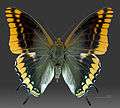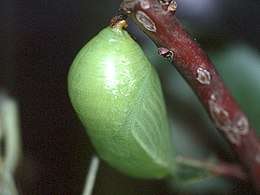Charaxes jasius
Charaxes jasius, the two-tailed pasha or foxy emperor, is a butterfly in the family Nymphalidae. It is the only European species of the genus Charaxes.
| Charaxes jasius | |
|---|---|
| Genova, Italy | |
_Greece.jpg) | |
| C. j. jasuis, Sithonia, Greece | |
| Scientific classification | |
| Kingdom: | Animalia |
| Phylum: | Arthropoda |
| Class: | Insecta |
| Order: | Lepidoptera |
| Family: | Nymphalidae |
| Genus: | Charaxes |
| Species: | C. jasius |
| Binomial name | |
| Charaxes jasius | |
| Synonyms | |
| |
Description
Charaxes jasius is a medium to large butterfly with a wingspan reaching 65–75 mm in males and 75–90 mm in females.[2] The uppersides of the wings are dark brown with orange margins. The hindwings bring two short tails, characteristic of most species of the genus. Close to these tails there are a few blue markings. The underside of the wings is reddish brown with numerous darker bands edged with white or gray. The orange marginal band is also present on the undersides of the wings and it is preceded by a white transversal band. Sexes alike.
 Upperside
Upperside Underside
Underside
Subspecies
- C. j. jasius (Southern Europe, North Africa)
- C. j. brunnescens Poulton, 1926 (Gabon, northern Angola, Central African Republic, south-western Democratic Republic of the Congo)
- C. j. epijasius Reiche, 1850 (Senegal, Gambia, Guinea-Bissau, Guinea, Mali, Sierra Leone, Liberia, Ivory Coast, Burkina Faso, Ghana, Togo, Benin, Nigeria, Niger, Cameroon, Central African Republic, Democratic Republic of the Congo, southern Sudan, northern Uganda, northern Ethiopia, Somalia, north-western Kenya) - cream-bordered charaxes
- C. j. harrisoni Sharpe, 1904 (south-western Uganda, south-western Kenya, north-western Tanzania)
- C. j. pagenstecheri Poulton, 1926 (southern Ethiopia, Somalia)
- C. j. saturnus Butler, 1866 (eastern and north-eastern Kenya, Tanzania, Malawi, central and southern Democratic Republic of the Congo, Angola, Zambia, Mozambique, Zimbabwe, Botswana, north-eastern Namibia, South Africa, Swaziland) - foxy charaxes or koppie charaxes
Type
This butterfly is the type species of the genus Charaxes.[3] The type location is Barbaria, Algeria.[4]
Related species
The members of the Charaxes jasius group are:
- Charaxes jasius
- Charaxes pelias – smaller than jasius
- Charaxes hansali
- Charaxes castor
- Charaxes brutus – dark with white bands
- Charaxes andara – Madagascar
- Charaxes ansorgei
- Charaxes phoebus
- Charaxes pollux
- Charaxes druceanus
- Charaxes phraortes – Madagascar, close to next
- Charaxes andranodorus – close to last
- Charaxes eudoxus
- Charaxes richelmanni
Distribution
This species occurs in the coastal Mediterranean region and Africa.[5]
In Africa, it has been recorded from North Africa, Senegal, Gambia, Guinea-Bissau, Guinea, Mali, Sierra Leone, Liberia, Ivory Coast, Burkina Faso, Ghana, Togo, Benin, Nigeria, Niger, Cameroon, Gabon, the Central African Republic, the RCongo and DRCongo, Sudan, Uganda, Ethiopia, Somalia, Kenya, Tanzania, Malawi, Angola, Zambia, Mozambique, Zimbabwe, Botswana, Namibia, South Africa and Swaziland.
In Europe, it occurs along the coast from west Portugal to the coastal islands of Greece (except for the northern Adriatic sea coast from the central peninsula of Italy to Istria) and the coastline of southern Anatolia including Samos, Ikaria and Rhodes. Its range includes the Balearic Islands, Corsica, Sardinia, Corfu and Crete. Inland, the butterfly is found in locally in Spain from Huelva and Malaga to Madrid and Salamanca. In France, the butterfly is found isolated inland from Provence to Lozère, Ardèche and Ayeron.[4]
Habitat

Its typical habitat in Europe is the Maquis shrubland, up to 700–800 meters above sea level. This comprises thick, mixed scrub forests, often on hillsides, in hot and dry regions. The butterfly is found wherever its larval host plants are abundantly available.[4]
In Africa it is found in savanna and thornbelt habitats.
Natural history
The two-tailed pasha is a fast-flying butterfly that displays territorial behaviour. The butterfly also is a noted for hill-topping. The adults of both sexes are attracted to fermenting fruits; they are attracted to the ethanol contained theirein, and can be baited with wine and other alcoholic beverages.[4]
Life cycle
Charaxes jasius is bivoltine, i.e. it has two generations per year.[4] The first batch of eggs are laid in May–June and the second in mid August–mid October.[4] The second batch caterpillars spend the winter in the larval stage, and pupate the next spring. The female lays the eggs on the upper surface of the leaves of the host plant, laying no more than one egg per leaf.[6]
The caterpillar is green, cylindrical and up to 50 millimetres (2.0 in) long. It has rings of yellow-white raised spots on the body, yellow lateral lines along the sides, and two yellow ocelli on the back. The head bears four horns facing backwards. The caterpillar makes a leaf tent from silken threads, to which it returns after feeding on surrounding leaves.[6]
When the caterpillar is fully matured, it hangs on a twig and pupates. The pupa resembles a ripening fruit as it is first green and becomes brown as the imago develops inside.[6] After a period that can range from two weeks to one month, the pupal case opens letting out the adult butterfly.
 Egg
Egg Larva
Larva Newly formed pupa
Newly formed pupa Pupa ready for hatching
Pupa ready for hatching Adult
Adult
Larval food plants
.jpg)
The larvae feed on a wide range of plants, including Afzelia quanzensis, Annona (including Annona cherimola), Arbutus unedo, Bauhinia (including Bauhinia galpinii and Bauhinia petersiana), Berlinia, Brachystegia (including Brachystegia edulis and Brachystegia spiciformis), Burkea africana, Cassia, Cassine, Catha edulis, Celtis africana, Colophospermum mopane, Copaifera baumiana, Croton, Daniella oliveri, Guibourtia conjugata, Gymnosporia (including Gymnosporia senegalensis), Hibiscus, Isoberlina, Julbernardia globiflora, Khaya senegalensis, Laurus nobilis, Lonchocarpus cyanescens, Lonchocarpus sericeus, Maytenus, Osyris lanceolata, Pleurostylia africana, Protea, Prunus persica, Pseudocedrala, Schotia brachypetala, Sorghum (including Sorghum roxburghii), Vaccinium corymbosum, Xanthocercis zambesiaca and Xeroderris stuhlmannii.[5]
References
- In the "Errata" of Systema naturae per regna tria naturae, secundum classes, ordines, genera, species, cum characteribus, differentiis, synonymis, locis, authored by Caroli a Linné, published in 1768 by Laurentius Salvius, Stockholm. Vide Sherborn, Charles Davies (1899). An index to the generic and trivial names of animals, described by Linnaeus, in the 10th and 12th editions of his "Systema naturae.". Dulau & co. Retrieved 19 April 2020.
- Woodhall, Steve (2005). Field Guide to Butterflies of South Africa. Cape Town, South Africa: Struik. ISBN 978-1-86872-724-7.
- Rydon, AHB (1971). "The Systematics of the Charaxidae (Lep. : Nymphaloidea)". The Entomologist's Record and Journal of Variation. London. 83: 219–233. Retrieved 15 March 2018. Pg. 220 "Recognising this fact, Ochsenheimer (1816, Schmett. Europa, vol. 4) removed Papilio jasius from Paphia, and placed it instead in his own genus Charaxes, thus making P. jasius the type-species of the latter by monotypy."
- Tolman, Tom; Lewington, Richard (2001). Butterflies of Britain and Europe. London: Collins, London. p. 143. ISBN 0-00-219992-0.
- "Charaxes Ochsenheimer, 1816" at Markku Savela's Lepidoptera and Some Other Life Forms
- James, David G. (17 October 2017). The Book of Caterpillars: A Life-Size Guide to Six Hundred Species from Around the World. University of Chicago Press. p. 207. ISBN 978-0-226-28736-2. Retrieved 17 April 2020.
External links
| Wikimedia Commons has media related to Charaxes jasius. |
- Images of Charaxes jasius, Charaxes jasius brunnescens, Charaxes epijasius, and Charaxes saturnus at Consortium for the Barcode of Life.
- Images of C. jasius brunnescens, C. jasius epijasius, C. jasius jasius, and C. jasius saturnus at Royal Museum for Central Africa (Albertine Rift Project).